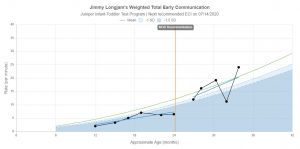 We use data every day to make decisions. You use weather data to decide if you need to wear a jacket. You refer to your fuel gauge to determine when to stop at a gas station. You use a thermometer to measure how sick your child is, and if it’s time to schedule a doctor’s appointment. Your doctor uses medical tests to diagnose an illness and recommend treatment options. So, with the availability of measures such as Infant-Toddler IGDIs, it also makes sense to use data to 1) know when children are not making expected growth on important outcomes, and 2) whether or not early intervention is improving a child’s growth in areas where there is a concern. The Division for Early Childhood’s (DEC) Recommended Practices for early intervention recommends that practitioners “Implement systematic ongoing assessment to identify learning targets, plan activities, and monitor the child’s progress to revise instruction as needed” (A9). A joint position statement of the National Association of Education of Young Children (NAEYC), DEC, and the National Head Start Association indicates that early childhood educators and service providers are increasingly called upon to use child data to individualize intervention to support children’s developmental priorities (e.g., cognition) within an MTSS/RTI approach (NAEYC et al., 2012). Infant and Toddler IGDIs were designed specifically to support progress monitoring and data-driven decision making for children 6 – 42 months of age. Learn more about how your program can use IGDI data to inform intervention decision making:
We use data every day to make decisions. You use weather data to decide if you need to wear a jacket. You refer to your fuel gauge to determine when to stop at a gas station. You use a thermometer to measure how sick your child is, and if it’s time to schedule a doctor’s appointment. Your doctor uses medical tests to diagnose an illness and recommend treatment options. So, with the availability of measures such as Infant-Toddler IGDIs, it also makes sense to use data to 1) know when children are not making expected growth on important outcomes, and 2) whether or not early intervention is improving a child’s growth in areas where there is a concern. The Division for Early Childhood’s (DEC) Recommended Practices for early intervention recommends that practitioners “Implement systematic ongoing assessment to identify learning targets, plan activities, and monitor the child’s progress to revise instruction as needed” (A9). A joint position statement of the National Association of Education of Young Children (NAEYC), DEC, and the National Head Start Association indicates that early childhood educators and service providers are increasingly called upon to use child data to individualize intervention to support children’s developmental priorities (e.g., cognition) within an MTSS/RTI approach (NAEYC et al., 2012). Infant and Toddler IGDIs were designed specifically to support progress monitoring and data-driven decision making for children 6 – 42 months of age. Learn more about how your program can use IGDI data to inform intervention decision making:
- Using IGDIs for data-driven decision making
- Using the Making Online Decisions (MOD) system for data-driven decision making
- Peer-reviewed publications on Infant-Toddler IGDIs

